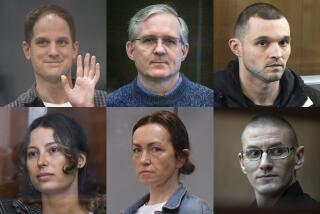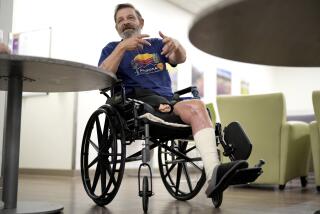U.S. Doctors and Nurses Help Treat Young Soviet Burn Victims
- Share via
MOSCOW — American and Soviet doctors together bowed over a 12-year-old girl Tuesday, removing dead and blackened skin from burns that covered 80% of her body.
“I know we are almost out of the antibiotic cream, but please tell them this is the child we must spend it on,” Dr. John Remensnyder, chief of staff at Boston General Hospital’s Shriners Burns Institute, told a translator.
In the next room, Patricia Salvo, a Boston General nurse, tried to explain what a hand splint is to her Soviet counterpart.
“I’m willing to improvise,” Salvo said. “But if we don’t get some kind of a brace to hold this child’s hand straight, it will curl up as the burned skin heals.”
Death Toll Mounting
More than two weeks after a gas pipeline explosion engulfed two trains in flames in the Ural Mountains, resulting in the deaths of more than 600 people, many of the survivors are still in desperate condition. The accident is claiming new lives almost every day.
Two days ago, a group of American doctors flew to Moscow to help.
The East-West medical cooperation is a sign of the times. The Soviet Union under President Mikhail S. Gorbachev has been more willing to publicly acknowledge disasters and accept aid from the West.
“The fact that the Soviets were ready to accept our help with only a little hesitation is an indication of a radically changed attitude here,” said a senior American diplomat here with long experience in the Soviet Union.
One of the first examples of such cooperation occurred after the 1986 accident at the nuclear power plant in Chernobyl, near Kiev in the Ukraine. Dr. Robert P. Gale of UCLA led a medical team that went to the Soviet Union to help treat firemen and others who suffered severe radiation exposure.
Triggered by Spark
Gorbachev has blamed negligence for the June 4 gas pipeline accident. He said monitoring systems showed a drop in pressure in a pipeline carrying liquid petroleum gas, indicating a leak. But instead of investigating, workers simply pumped more gas into the line to raise the pressure. So a leak turned into a pool and the explosion triggered by a spark from a passing train was as powerful as a 10,000-ton bomb.
The fiery blast melted train cars and left survivors with wounds of a type and severity seldom seen.
The American burn specialists are working with their Soviet counterparts in Moscow’s Hospital No. 9, the area’s burn center for children, treating youngsters ranging in age from 2 to 14.
The cases they have encountered are grim. Three of the 26 children airlifted to Hospital No. 9 have died, including one who died Monday. Another two or three children, including the 12-year-old girl the doctors were working on, are unlikely to last through the weekend.
In one ward, 5-year-old Olessya Golobosky, so thin the American doctors asked how often she was being fed, and with burns over 40% of her body, was described as one of the lucky ones. Her father was at her bedside although she didn’t know yet that her mother had died three days ago.
“I didn’t get to see her until just two days ago, because I was with my wife,” said Olessya’s father, Viktor. “Olessya and I have not spoken much about the accident. When she is sleeping she sometimes is shaken by convulsions, although I am not sure if it is pain or nightmares.”
Dr. Remensnyder and his colleagues examined Olessya, asked that her dressings be changed every day instead of every other day as is the usual practice in Hospital No. 9 and suggested that she receive a skin graft before the weekend, to be jointly performed by doctors from both countries.
In the same room lay 2-year-old Marina Demkin from southern Siberia. Her mother died Monday and her father is still hospitalized in serious condition. “Her father threw her out a window and that probably saved her life,” explained Soviet nurse Nadia Medlen.
“Sometimes she cries for her mother, but mostly Marina is very quiet. She stays awake until 2 in the morning, looking at books. Sometimes she tries to tear off her bandages.”
In another room, 5-year-old Ira Skopinok lay on a mattress filled with air intended to put as little pressure as possible on her burns. “Mommy, mommy,” she cried to visitors who bent over her to say hello.
“Her parents are hospitalized in another city,” a doctor explained.
Each of the children have their own horror stories. Many saw their parents on fire. Many have not seen one or either parent since the accident.
“They must recover psychologically as well as physically,” said Dr. Valentin S. Okatyev, who has worked at Hospital No. 9 for 23 years.
In addition to dressing and treating wounds, the American specialists have sought to comfort and communicate with the children without the benefit of a common language. One trick Remensnyder uses is to sit on the floor so the Soviet children can see the foreign doctor at eye level instead of being forced to look up at him.
More Help on Way
The Americans plan to spend two weeks at the hospital. The doctors brought medical supplies with them with funding from the Virginia-based Project Hope humanitarian agency, and more is on the way, Remensnyder said.
This week marked the first time doctors at Hospital No. 9 had ever worked with foreigners. The Soviets and the Americans were both curious about one another’s practices.
“Who changes the dressings in America, the doctors or the nurses?” one Soviet doctor asked Remensnyder.
“Do you use scissors just like us, or do you use other equipment to remove burned skin?” a Soviet resident doctor asked his Boston General counterpart, Dr. Kurt Reinke.
For his part, Remensnyder asked to see the operating room where skin grafting is done and to look at the type of scalpels used.
The American and Soviet nurses, too, generally worked together quickly and efficiently.
“We’re a great team,” Salvo told Medlen as they prepared gauze bandages to place on a burned child. Medlen speaks no English but understood the general sense and smiled back at Salvo.
“Of course we do not always agree, but we can find a compromise,” said Okatyev. “The American doctors believe in peeling away dead skin within a day or two after a child is burned, and we prefer to wait for the skin to fall off. Now it is more than two weeks after the accident, so we are using a slower time frame but still employing many of their techniques.”
In addition to differences over radical versus conservative approaches to treating burn victims, the Soviet hospital’s sterilization procedures are not like those in the United States.
Patients at Hospital No. 9 were carried or wheeled into a single dressing room where they were placed on a stationary bed, their bandages were peeled off and they were examined by doctors.
All staff and visitors wore robes and face masks, but the door to the room stood open. Most of the equipment was cleaned, but not sterilized, before being used again.
Remensnyder said all the burn victims in Hospital No. 9 now have skin infections. But so far the Americans have focused on praising the care the children have been given, instead of criticizing differences in U.S. and Soviet medical systems.
“The main purpose of this cooperation is to save lives,” Remensnyder said. “Sometimes it seems like battlefield conditions. We don’t always have a lot of time to talk theory. We just have to work together well.
“But I am hopeful that we will get out of this acute stage at some point during our stay here,” he said, “and have a chance to discuss broader issues.”
More to Read
Sign up for Essential California
The most important California stories and recommendations in your inbox every morning.
You may occasionally receive promotional content from the Los Angeles Times.









